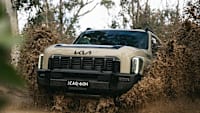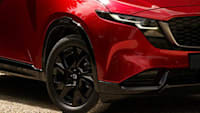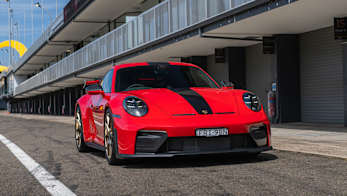The electrification of the automotive industry is a monumental, once-in-a-generation shift, and like the environment, these kinds of changes are usually accompanied by an extinction event.
Some manufacturers, like Hyundai and Kia, for example, are more ready to embrace change than others, never shying away from battery electrics or hydrogen. Others, like brands which fall under the Volkswagen Group umbrella have learned hard lessons and made a heavy pivot toward electrification, yet some brands seem much less prepared, with electrification not set to debut until 2030 or beyond.
This year, though, Australians finally seem ready to start adopting electric cars on a mainstream scale, with sales up a whopping 292 per cent year-on-year, expanding faster than many predictions thanks in large part to a surge of lower-cost Chinese electric vehicles from the likes of BYD, MG, and GWM, as well as more free-flowing supply for the already-popular Tesla Model 3 and Model Y.
Now that popularity is exploding, will it be too late for some laggard brands by the time they get there? Here's our list of car manufacturers which have the most vague or non-existent electrification plans in the Australian market, and what they've said they're going to do about it in the near future.
-
The worst carmakers for EVs: the electric car tortoises, including Toyota, Ford, Mitsubishi, Mazda, Subaru and others, and what they're doing about it... EV-entually!
-
Honda, Ford, Subaru, Mitsubishi and the other big car brands with no confirmed electric car plans
-
Onto the grid: Australians have bought five times as many electric cars this year than last thanks mostly to Tesla
Isuzu Ute

EVs planned for Australia: None
Personally, I quite like the Isuzu Ute underdog story. This is a brand which maintains a top-10 position in the Australian market, by just focusing on two tough ladder frame vehicles, specified exactly to what the Aussie adventurer, fleet buyer, or towing aficionado needs.
The future for this brand is murky though, because globally Isuzu has its EV plans set way back to 2030 and beyond, committing fully to diesel in the interim, eschewing even mild-hybrid technology in favour of straight combustion.
There are certainly flickers of hope for the brand, as globally Isuzu has a strategic partnership with Honda to investigate mainstream applications of hydrogen fuel-cell technology (theoretically great for light-commercial vehicles), and it has already embarked on launching a variety of different experimental drivetrains in its light and medium truck range in Japan. We'll find out before long, with the latest news being reports of an electric D-Max hitting the market overseas as early as 2025.
Alfa Romeo
.jpg)
EVs planned for Australia: None
Alfa has had more stops and starts than most other brands in recent memory, and despite a recent promising push in the performance realm with the Giulia sports car and Stelvio SUV, the Italian marque seemed to have fizzled out again, only just trying to restart the fire with the Tonale small SUV.
It's finally a car in a more mainstream segment which buyers might actually want, and this time around will have a plug-in hybrid version, but is dependent on other Stellantis-owned brands for its tech. For Aussie buyers - what's to set it apart from other oddball semi-premium and premium European options like Peugeot, Volvo, and Skoda - all of which are much further down the electrification path?
On the cards for the future is a new-generation fully electric Giulia which is supposed to break cover in 2025, riding on a shared Stellantis EV platform, and will reportedly move away from its sedan roots to a shape which "will cover multiple segments" whatever that means. I suppose we will have to wait to find out.
Jeep
.jpg)
EVs planned for Australia: One (Jeep Avenger)
There's a lot of Stellantis-owned brands in here. I'm sure the group has a plan for solving this seemingly global problem, but Jeep is up against it with only one plug-in hybrid in Australia alongside a big, thirsty non-turbo V6 also powering its flagship Grand Cherokee.
The main issue here is the brand's vehicles are desirable for their adventurous nature, something which is hard to do with a battery electric vehicle, in conditions where charging locations are scarce and adding more range will simply stack weight onto the car, and dollars onto the price.
That's not going to stop Jeep from trying to again break into the more passenger-oriented market segment, with its just-announced upcoming Avenger electric small SUV. More city-focused than the once-popular Grand Cherokee, it's hardly the cool-looking Wrangler Magneto concept the brand showed a few years ago, but it is a step in the right direction.
Ferrari
.jpg)
EVs planned for Australia: None (one unnamed 2025 project in the works)
There are few things more associated with Ferrari than the colour red and the sound they make. What happens when they no longer make that sound? Can an EV be traded on wild Italian styling, stratospheric prices, and the colour red alone? And if Ferrari continues holding the torch for combustion a while longer - is it at risk of becoming irrelevant as electric rivals both new and old get faster?
Actually, if I think any brand stands a chance, it's Ferrari. It might not find the same customers it once did when combustion engines exit the picture, but the Prancing Horse has always been a resilient status symbol, especially if the sold-out Purosangue "not-an-SUV" and the well-received plug-in hybrid SF90 are anything to go by.
To boot, its first fully electric vehicle should be well into development by now, with a launch date expected by 2025. No doubt it will be pivotal for the future of the brand.
McLaren
.jpg)
EVs planned for Australia: None
McLaren, the way I see it, currently has very much the same problem as Ferrari, but perhaps even worse. The brand won't even adopt an SUV into its line-up of performance vehicles, let alone an electric model (that's not to say I actually want McLaren to build an SUV, it just seems like the right financial decision), however at very least the brand's more recent Artura employs an interesting plug-in hybrid setup, which combines a 3.0-litre V6 with a 70kW electric motor and tiny (for weight-reduction purposes) 7.4kWh battery which is good for just over 30km of electric-only driving.
McLaren also has bigger electric plans to sell something more akin to the Porsche Taycan in the coming years, which the brand's CTO mysteriously described to media overseas as "not necessarily higher-riding, but it could be."
Honda
.jpg)
EVs planned for Australia: None
Honda is having a hard time in Australia thanks to an ageing range of primarily combustion vehicles, despite having solid roots overseas in hybrid, battery electric, and hydrogen tech. Unlike its Toyota rival though, none of these projects look likely for the Australian market.
The quirky Honda e small hatch, for example, has even made it all the way to the UK and yet there's no sign of it in Australia, even though it would likely carry a high price and offer a limited range.
To make matters worse, the brand's next promising project, a next-generation mid-size SUV, will both be built in America as part of a joint-venture to utilise General Motors' Ultium battery technology and its BEV3 platform. In other words, don't hope for a right-hand-drive version any time soon, much less for its 2025 launch window.
At least Honda's fortunes will soon turn around for its range of combustion and hybrid cars, with the arrival of the ZR-V and new-generation CR-V, but it could be a long time before we see any Honda-badged battery electrics Down Under.
Citroen

EVs planned for Australia: None
Citroen is already selling just a handful of charming but underrated cars in Australia to a very niche audience every year, but unlike its larger Peugeot sister brand it has no plans to introduce its range of battery electrics, like the odd e-C4 X available over in Europe to the Australian market.
One argument says the French marque could hardly get more niche as it is in Australia, and if anything, an accessible EV might help its fortunes, another says having a single expensive electric model could dry up the remaining sales the brand has left. A conundrum indeed.
Chevrolet
.jpg)
EVs planned for Australia: None
Giant, America-sized V8 pick-up trucks are one of the hottest trends on the Australian market right now, despite eye-watering six-figure price-tags and the need for them to be converted to right-hand drive locally.
GMSV (General Motors Specialty Vehicles) was one of the quickest to hop on this, rivalling the Ram 1500 with its Silverado, allowing the relatively small import brand to rocket up the sales charts, but does the business model work with an already enormously expensive electric version? With the complexities of a modern electric architecture, will something like a Silverado EV ever be able to be swapped to right-hand drive? We'll have to find out soon.
Mitsubishi
.jpg)
EVs planned for Australia: One* (*The eK X city car is currently undergoing local testing)
Mitsubishi shares a problem with many other Japanese automakers, in that it's a little behind where it should be when it comes to its global electric vehicle roll-out.
In a way, this is by design. Mitsubishi plays an important role as part of its alliance with Nissan and Renault as the brand responsible for providing light commercial and lower-cost vehicles for the South East Asian market.
But Australia, with its newfound taste for electric vehicles, as well as our high equipment and safety standards, is one of Mitsubishi's strongest markets, and the brand has vowed to reorient itself back towards us now that its previous objectives are near complete with the upcoming launches of the Triton, Xforce, hybrid Xpander, and next-gen Pajero Sport overseas.
One short-term possibility is the eK X fully electric city car, which the local division is currently in the process of testing, but the question remains whether it will be too little too late before Mitsubishi has something a bit more mainstream to offer in the battery electric space, much later this decade.








.jpg)










.jpg)


.jpg)
.jpg)
.jpg)
.jpg)


.jpg)

.jpg)